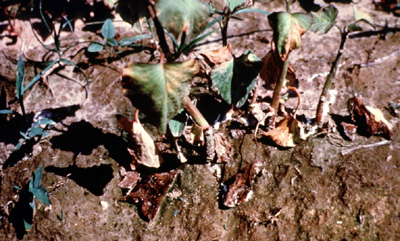|

Severely
infected plant after stems are girdled by Sclerotium
rolfsii (C. Clark, APS).

An
infected plant showing yellowing of lower leaves and characteristic
white fan-like structure (C. Clark, APS). |
Diagnostic summary
-
usually appears as isolated patches in plant beds.
-
in the field, appears when plant canopy has fully covered the
soil surface.
-
affect plants at or below the soil surface.
-
initially, there is yellowing of lower leaves and wilting.
-
depressed, water soaked, sunken lesions
in stem, which at later stage, are covered with a white fan-like
mycelium. Soon after, the stem is girdled and the plant eventually dies.
|
Taxonomy
Economic
importance
Geographical
distribution
Morphology
Symptoms
Biology
and ecology
Host
range
Inspection
and diagnosis
Management
References
View
full fact sheet
|

